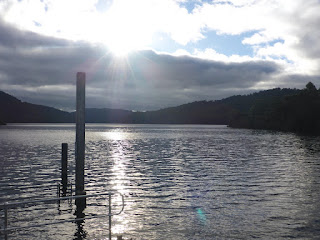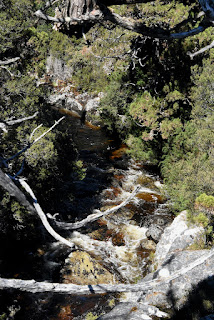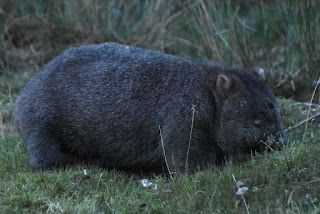Strahan certainly seemed big enough to deserve a petrol station, and the BP site was there where the map indicated it, but there were no pumps and the building was closed. Very odd. So we drove on to Queenstown. There was no petrol on the main road we arrived by, which was also odd, but the satnav indicated some options. A tiny forecourt on a side street offered the usual range of fuels and we replenished the tank.
Our destination for the night was Tullah Rest Area. There are no signposts and we had to hunt for a bit. (We only worked out later that the camping app will zoom to show every street. We could have followed its map.) There was one other camper van parked there; a lady with two dogs. One of the dogs was 19, ancient for a dog, and she didn't come to greet us. The other dog was very friendly. One of the small-with-a-squashed-face breeds, it took a great liking to Bill. Yet another oddity. Bill and dogs generally ignore each other.
The rest area is adjacent to the Tullah Jetty on Lake Rosebery.
The next day's adventure was Cradle Mountain. It's a huge national park, with trails from 10 minutes to several days.
Before we got there we invested some time at the Black Bluff lookout.
Most visitors have to park at the information centre and take the shuttle, or use their feet. It was the only time we were asked to present our parks pass. We prepared ourselves with a coffee and filled our water bottle from the water station.
The first 'stop' on the shuttle route is the Interpretation Centre and Ranger Station. For our first walk we took the easy trail to Knyvet Falls and Pencil Pine Falls. It is nearly all boardwalk, so it is not arduous and the forest is lovely.
We had been told that wombat droppings are shaped like cubes. We were sceptical. What kind of intestine and muscle arrangement would generate cubes. The Cradle Mountain Park is well populated with wombats and they provided plenty of droppings to examine. In the event, they are regular-sized pellets, but without sharp edges and corners.
There is a boardwalk to Dove Lake. The information centre recommended the section from the Ranger Station to Ronny Creek as a good path for observing birds. It's advertised as a 40 minute walk. Eve decided that her hip joints were in good enough order to tackle it.
In the event, we saw hardly any birds except a few Forest Ravens, but we did see lizards, a large dragonfly and other insects. Again, the boardwalk made the journey easy and, even at our relaxed pace, it only took 40-45 minutes.
There are picnic tables by the Ronny Creek car park. We took advantage of this for a lunch stop. There was a fizzing sound when we unscrewed the top of the water bottle. The water station at the information centre had dispensed sparkling water. What a lovely surprise.
Lunch attracted birds; numerous Forest Ravens and a trio of Native Hens.
The boardwalk carries on to Dove Lake, but we took the shuttle. There is a moderately difficult 8km circuit around the lake, but that would have been risking too much aggravation from the hips. And at 2 hours it was too long for Bill to happily leave Eve on her own. He did go to the boatshed and back and took some photos.
There and back should take no more than 20 minutes, but Bill got into a conversation. It started with cameras and carried on into travel and .... I hope Eve didn't get too anxious.
Every trip on the shuttle the driver reminds the passengers that the last shuttle back is at 5:30. It would probably be very crowded and what happens if it overflows? We opted not to wait until the last shuttle. But Bill did want to have another look around Ronny Creek, which is advertised as a really good place to see wombats in the evening. Since we saw platypuses in broad daylight maybe we would also see wombats in the sunshine. The bus driver reckoned we would. “There's always wombats at Ronny Creek.” As the bus pulled up he indicated two groups of people staring at something. “They're watching wombats.”
And they were. We shouldn't complain, since we definitely saw wild wombats, but the wretched marsupials either crouched down in the grass so we could only see their back, or they faced the other way so we could only see their backside, or they put themselves right in front of the sun so that their face was in deep shade and invisible in the photographs.
All the wombats we had seen previously had been grey, but these were brown. The field guide only includes one species of wombat in Tasmania, the Common Wombat. Subsequent Internet research reveals that wombats can be sandy to brown, grey or black.
We boarded a shuttle bus back to the information centre. It wasn't the last shuttle, but all the seats were occupied and Bill had to stand. It had hardly driven 200m when the driver called out, “There's a wombat”. He helpfully stopped so all the passengers could get a good look. Bill still had his camera around his neck so he got a couple of photos.
The closest campground was full, but the information centre directed us to another one not far away. Cradle Mountain Fishery and Camping offers a piece of level ground and a couple of Portaloo toilets. It also offers, for a fee, the chance to catch a trophy trout. We parked the van in a spot overlooking the dam (artificial lake) but we didn't go fishing.
It had been a lovely day. The sun had shone. It wasn't too hot or too cold. We could very happily revisit Cradle Mountain National Park and walk more of its trails. But we only had two more days in Tasmania. We had to move on.

















.jpeg)








No comments:
Post a Comment